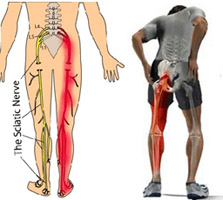Slip Disc
The intervertebral disc is a shock absorbing cushion like pad between the two adjoining vertebral bodies of the back bone. These discs are made up of an outer firm covering and an inner core of jelly like material. When this jelly like material leaks out, it produces pressure on the spinal cord or the nerve roots causing pain in the lower back which radiates down to the legs or neck pain that radiates down the upper limbs. This is called prolapse disc, disc herniation or simply slip disc. 
Patient Symptoms
TheSubmit pain can be moderate to severe electric shock like or burning. In addition their can be tingling, numbness or some weakness of muscles. SCIATICA is a symptom and not a disease. It connotes the pain that start in the lower back and goes towards the legs. Many diseases can cause the symptoms however, slip disc is the most important cause.
TREATMENT OPTIONS FOR SLIP DISC
• CONSERVATIVE TREATMENT (NON SURGICAL)
• OPERATIVE TREATMENT (SURGICAL)
Many patients especially those having first attack of slip disc respond very well to conservative (Non Surgical treatment) however about 10-15% of all patients require surgical interventions. The success rate of surgical treatment varies between 50-95% depending on various factors. Up to 5-15% of operative patients may require re-surgery due to various reasons such as dural fibrosis, arachnoid adhesions, mechanical instability or muscle/fascia weaknes.
• NEWER ALTERNATIVE TREATMENTS FOR SLIP DISC
Newer non operative techniques have been developed as alternative to surgical options for the patients not responding to conservative treatments (non operative).
• Ozone discectomy
• Epidural steroid or Ozone steroid injections
• Chemonucleolysis
• Annuloplasty (IDET)
• Percutaneous discectomy
- Nucleoplasty
- Disc dekompressor
- laser discectomy
- APLD
• Endoscopic percutaneous discectomy
• Epidural steroid or Ozone steroid injections
Epidural steroid injections with or without ozone is a technique to relieve chronic spinal pain. It can be given by lumbar, caudal, thoracic or cervical route depending up on the site of pathology.
It reduces inflammation, blocks transmission of nociceptive C-fibre inputs and prevents ectopic discharge from axon and dorsal root ganglia. Immediate relief is more than 85% but long term relief is nearly 50%. Earlier it is done, better is the long term relief. Best results are obtained in disc herniation with poor outcome in non specific back and neck pain.
| OZONE DISCECTOMY (NUCLEOLYSIS) | SURGICAL DISCECTOMY |
| No general anaesthesia needed | General anaesthesia required |
| Duration of procedure (about 30 mins) | Requires about 1-2 hrs |
| Done as a day care procedure | Requires at least 2-3 day hospital stay |
| Success rate of about 70-90% | Success rate of about 50-95% |
| Percutaneous procedure (less invasive) | Comparatively much more invasive |
| Very few side effects and complications | Comparatively more side effects |
| Shorter hospital stay and cheaper | Costlier as longer hospital stay |
| Patient goes back to work quickly | Comparatively patient needs more time to go back to work |

